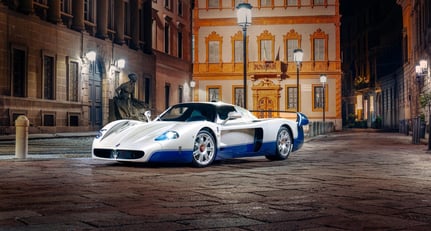
Imagine you are walking back home after a nice dinner among friends through the empty streets of downtown Milan, when you hear a throaty howl from behind the next corner. Having watched too many Japanese horror movies as a teenager, you instantly expect Godzilla to emerge and crunch some of the luxury boutiques on Via Montenapoleone. But fortunately, the beast that enters the scene is a way more appealing type of fire-spitting monster, a rare creature known to most of us only from automotive fairytales; a pearl-white unicorn one might say. While you gaze in awe, the Maserati MC12 creeps past you at waist level toward La Scala, the driver hidden below the low roof as the aural fury of its Enzo-derived 6.0-litre V-12 engine filling the streets.

Speaking of the Ferrari Enzo: the Prancing Horse from Maranello might have caused a bigger stir when it was launched as a supercar successor to the mythical GTO, F40, and F50 lineage in 2002. Released two years later, and based on the same carbon fibre monocoque, gearbox and engine, the Maserati MC12 was announced with less fanfare. And the styling, developed by concept design director Frank Stephenson based on an idea by Giorgetto Giugiaro, was more organic than Ken Okuyama’s fissured, butterfly-doored Ferrari Enzo design that took the Scuderia’s F1 styling to the extreme. If you see both cars together, it’s stunning to see how much wider, longer, taller (and in fact more aerodynamic) the Maserati is compared to the Ferrari. After all, the MC12 had been developed to take Maserati back to the track. Maserati stated that two batches of twenty-five cars were built in 2004 and 2005 respectively, although it is though that the true number of road cars is likely to be much lower, probably in the high thirties. Ten times as many Ferrari Enzos left the Maranello factory.

We vividly remember taking the white and blue press kit from the envelope with the Italian stamp on it, putting the CD-ROM into the drives of our iMacs and marvelling at the elegant images of the pearl-white supercar with its dark blue accents and 2-metre-spoiler on its rear. Twenty years after it was first revealed at the Paris Motor Show, the Maserati MC12 has become the most sought-after of all supercars of its era – particularly because it is so rare, but maybe even more so because there have been no comparable, track-derived supercars from Maserati to this day. One has to remember that the 1990s was a difficult period for Maserati, and after the Italian government saved the company from bankruptcy and Fiat sold the brand to Ferrari, the early 2000s were a period of hope. While the new 3200 GT and Quattroporte put the Modenese marque back on the map, the MC12 signaled a return to motorsport glory, particularly the GT1 class of the FIA GT championship. The sky, so it seemed, was the limit.

Like the Bugatti EB110 from the early 1990s -- a torchbearer of optimism and an ambassador of technological progress for the struggling Italian car industry -- the Maserati MC12 has the aura of exceptionalism and a very unique, slightly weird, but very impressive vibe to it. Having seen it live again at recent events like the Concorso d’Eleganza Villa d’Este or The I.C.E., we can say that the MC12 has aged better than any other supercar from its era, and in our humble opinion there has been no other street-legal racecar with a similar presence since the McLaren F1 GTR Longtail. Similar to the F1, the racing success of the MC12 Versione Corse increased the desirability of the road-legal MC12 Stradale. In 2005, Maserati stormed to victory in the FIA GT Manufacturer’s Cup, scoring almost twice as many points as Ferrari. The MC12 further distanced itself from its Maranello rival on the road thanks to a spectacular removeable hardtop that aped that of the F50, allowing both driver and passenger to experience the full aural fury of its V12 engine while working on their tan.



A total of only 13 examples of MC12 Versione Corse were built, one prototype and 12 customer cars. A bright orange example is coming up for sale with RM Sotheby’s on 31 January during their Paris auction, it is estimated to fetch 2.8 to 3.5 million euros. All street versions bore the iconic two-tone Fiji White and blue paint, except a black car built for Michael Schumacher. The example presented here, chassis number 12081, is among the earliest by chassis number and was completed by the factory in November 2004. Interestingly, rather than being supplied directly to its new owner, this MC12 was retained by the factory and is believed to have been used for promotional purposes before the car was delivered to its first private owner in April 2006, some 18 months after its completion. Was it used as a press car? Or did the team at Maserati just find it hard to let go of their new halo car? We won’t know for certain.

The car’s first private owner was the official Maserati importer in Malaysia. The car was shipped to Kuala Lumpur, where it remained on display as a cornerstone of the owner’s collection for approximately 10 years, during which it accumulated limited mileage. The Maserati returned to Europe with its next owner and was registered in Germany, where it has remained ever since, currently displaying less than 6,700 kilometres from new. Estimated to fetch between four and five million euros, the extraordinary example of Maserati’s homologation-special supercar is offered with no reserve by Sotheby’s Sealed in Munich. You can make your bid between 31 January and 7 February 2024.

























